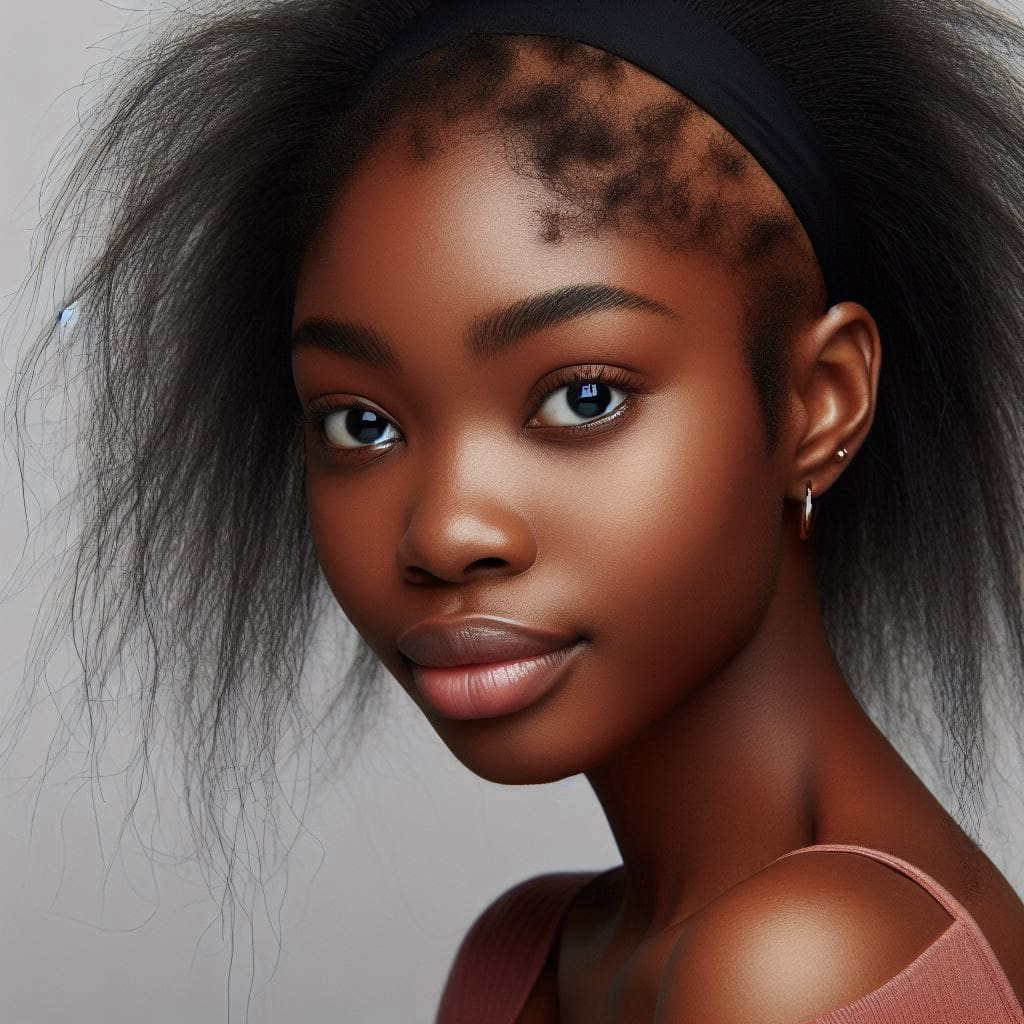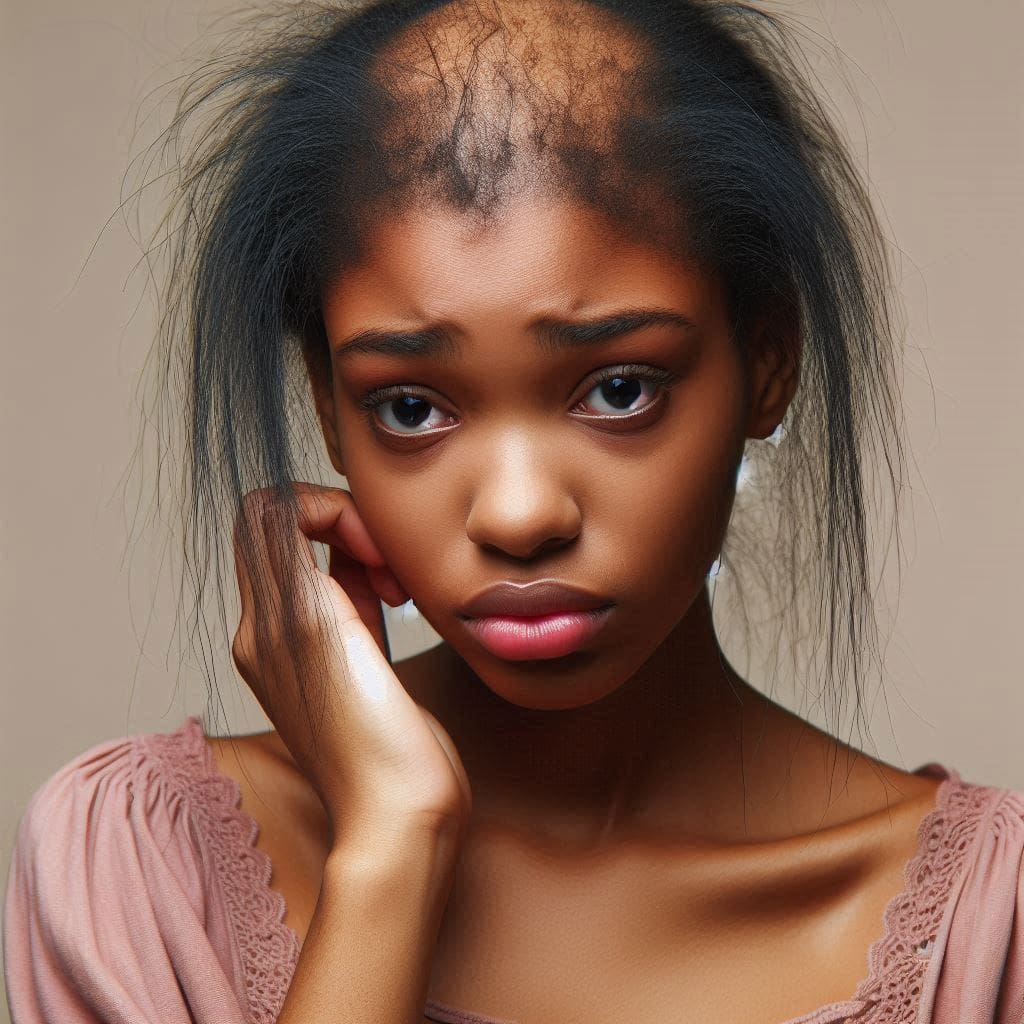
Ever woken up to find a bald patch on your head, out of nowhere? Or maybe you’ve noticed your eyebrows or eyelashes thinning? If so, you might be experiencing alopecia areata, a mysterious condition that causes hair loss.
While it can be alarming, it’s important to remember that alopecia areata is often temporary and treatable. Let’s unravel the mystery behind this condition and learn how to cope with it.
Alopecia areata is a condition that causes sudden hair loss in small patches, often on the scalp, but it can also affect other areas like the face and body.
Alopecia areata is also generally called patchy hair loss because it typically causes hair to fall out in small, round patches on the scalp or other parts of the body.
What is Alopecia Areata?
The affected hair usually falls out in small, round patches. In some cases, people may lose more hair, and in rare cases, all the hair on the body can fall out.
Causes of Alopecia Areata
While the exact cause of alopecia areata is not fully understood, it’s known to be an autoimmune condition. Some factors that might trigger the condition include:
- Genetics: People with a family history of autoimmune diseases are more likely to develop alopecia areata.
- Stress: Emotional or physical stress can trigger the onset or worsen the condition.
- Illness: Some medical conditions may play a role in causing alopecia areata.
- Environmental Factors: Pollution or exposure to certain chemicals may also contribute.
Who Can Get Alopecia Areata?
People with other autoimmune diseases, like thyroid disease or type 1 diabetes, may also have a higher risk of developing it.
Symptoms of Alopecia Areata
The main symptom of alopecia areata is hair loss that happens suddenly and in round patches.
Other symptoms may include:
- Brittle nails: In some cases, people with alopecia areata also experience changes in their nails.
- Itchy scalp: Before the hair falls out, you may notice itching or burning in the affected area.
Additional Symptoms of Alopecia Areata
1. Hair Loss in Other Areas
- While alopecia areata often starts on the scalp, it can also cause hair loss on other body parts like the eyebrows, eyelashes, beard, or arms.
2. Regrowth of White or Gray Hair
- In some cases, hair grows back white or gray at first, even if your natural hair color is different. Over time, it may return to its original color.
3. Sudden Hair Loss
- The hair may suddenly fall out in clumps over a short period, sometimes overnight or within a few days.
4. Thinning Hair
- Instead of patchy hair loss, some people may experience overall thinning of their hair, making it appear less dense.
Classifications of Alopecia Areata
Alopecia areata comes in different types depending on the extent of hair loss. Below are the main classifications:
- Alopecia Areata (Patchy): This is the most common type. Hair loss happens in small, round patches on the scalp or other areas like the beard or eyebrows.
- Alopecia Totalis: In this type, all the hair on the scalp is lost. It may start with patchy hair loss that worsens over time.
- Alopecia Universalis: This is the rarest and most severe form. People with alopecia universalis lose all the hair on their scalp, face, and body, including eyebrows, eyelashes, and body hair.
- Diffuse Alopecia Areata: This type involves sudden thinning of hair all over the scalp, rather than patches. It can look similar to other hair loss conditions, so diagnosis is important.
- Ophiasis Alopecia Areata: This form affects the hair around the sides and back of the head. The hair loss follows a band-like pattern, which can be harder to treat.
Psychological Effects of Alopecia Areata on Mental Health and Well-Being

Alopecia areata can have a big impact on a person’s mental health and well-being.
Losing hair, especially in noticeable patches, can be hard to cope with emotionally.
Here are some common psychological effects:
1. Low Self-Esteem
- Hair loss can make people feel less confident about their appearance. This can lower their self-esteem and make them feel embarrassed or self-conscious in public.
2. Anxiety
- Worrying about hair falling out or what others might think can cause constant anxiety. Some people may feel anxious about going out or interacting with others.
3. Depression
- The stress and emotional pain caused by alopecia areata can lead to feelings of sadness or depression. It can be especially tough for people who view their hair as an important part of their identity.
4. Social Withdrawal
- Some individuals may avoid social events or feel uncomfortable being around others due to the way they look. This can lead to loneliness or isolation.
5. Body Image Issues
- The change in appearance can affect how people see themselves, leading to negative body image and frustration. This can make it harder to accept or love their new look.
6. Emotional Stress
- Constant emotional stress may result from not knowing how much hair will fall out or when it will grow back. This uncertainty can cause frustration and emotional ups and downs.
7. Impact on Daily Life
- Dealing with alopecia areata can affect daily life, work, and relationships, as individuals may spend time and energy trying to cover or manage their hair loss.
In short, alopecia areata doesn’t just affect physical appearance; it can also have serious effects on mental health and well-being.
It’s important to seek emotional support, whether through counseling, support groups, or talking to loved ones, to help manage the emotional impact of hair loss.
Diagnosing Alopecia Areata
To diagnose alopecia areata, a dermatologist will typically:
- Examine the affected area: They may inspect your scalp or other areas where hair loss has occurred.
- Review your medical history: Your doctor will ask about family history or any other autoimmune conditions.
- Perform tests: In some cases, a skin biopsy or blood test may be needed to rule out other causes of hair loss.
Treatment for Alopecia Areata
There is no cure for alopecia areata, but there are treatments that can help manage the condition and encourage hair regrowth. Some of these treatments include:
- Topical corticosteroids: Creams or ointments that help reduce inflammation in the hair follicles.
- Corticosteroid injections: These are injected into the areas with hair loss to stimulate hair regrowth.
- Minoxidil: An over-the-counter treatment that can help promote hair growth.
- Immunotherapy: This involves applying chemicals to the skin that may trigger hair growth by stimulating the immune system.
- Light therapy: This treatment involves exposing the scalp to ultraviolet light.
- Support groups: Talking to others with alopecia can help you manage the emotional effects.
Living with Alopecia Areata
Living with alopecia areata can be challenging, but many people find ways to cope. Some tips for managing the condition include:
- Wearing wigs or hats: These can help you feel more comfortable with your appearance.
- Focusing on what you can control: Try not to stress over hair loss and instead focus on the things you can manage, like your overall health and well-being.
- Seeking emotional support: Talking to a counselor or joining a support group can help you deal with feelings of anxiety or depression related to alopecia areata.
How to Prevent Alopecia Areata: Simple Tips to Protect Your Hair
Alopecia areata is a condition where your immune system mistakenly attacks your hair follicles, leading to hair loss in patches.
While there is no sure way to fully prevent it, you can take steps to reduce the chances of it happening or manage the condition better if you’re already experiencing it.
1. Manage Your Stress
Stress is one of the major triggers of alopecia areata. When you are stressed for a long time, it can affect your immune system, which may cause hair loss. Here are a few ways to reduce stress:
- Practice relaxation techniques like deep breathing or meditation.
- Get enough sleep to allow your body to recharge.
- Take short breaks throughout the day to relax your mind.
2. Maintain a Healthy Diet
A balanced diet rich in vitamins and minerals can help strengthen your hair and overall health. Foods that are good for your hair include:
- Leafy greens like spinach and kale, which are rich in iron.
- Nuts and seeds for omega-3 fatty acids.
- Eggs and lean meats for protein and biotin.
These nutrients help keep your scalp and hair healthy, reducing the risk of hair loss.
3. Keep Your Scalp Clean
Good scalp hygiene can prevent hair damage and promote hair growth. Here’s how to care for your scalp:
- Wash your hair regularly with a mild shampoo to remove dirt and oil.
- Avoid harsh hair treatments like excessive heat styling or chemical products that can weaken your hair.
4. Avoid Pulling or Tight Hairstyles
Tight hairstyles like ponytails, braids, or buns can put stress on your hair and scalp, causing hair breakage or loss.
Instead, opt for looser hairstyles that allow your hair to breathe and reduce tension on your hair follicles.
5. Strengthen Your Immune System
Since alopecia areata is linked to the immune system, having a strong immune system can help. Simple ways to boost your immune system include:
- Eating a diet rich in fruits, vegetables, and whole grains.
- Exercising regularly to keep your body active and healthy.
- Drinking enough water to stay hydrated.
6. Avoid Smoking and Alcohol
Smoking and excessive alcohol consumption can weaken your immune system and damage hair follicles, leading to hair loss.
Cutting back or quitting smoking and limiting alcohol intake can help prevent hair loss and improve your overall health.
7. Talk to Your Doctor
If you notice signs of hair loss or alopecia areata, it’s important to talk to a healthcare professional.
They can offer treatments or advice on how to manage your condition and prevent it from getting worse.
Home Remedies for Alopecia Areata
Here are some simple home remedies that may help manage the symptoms of alopecia areata:
1. Aloe Vera
Aloe vera is known to reduce inflammation and help with hair growth. Apply aloe vera gel to the areas with hair loss, leave it on for 30 minutes, then rinse it off.
2. Onion Juice
Onion juice can also help promote hair growth. Apply it to the affected areas, leave it for 30 minutes, then wash it off.
3. Coconut Oil
Massaging coconut oil into your scalp can help boost hair growth.
4. Essential Oils
Using essential oils like lavender, rosemary, and peppermint on the scalp may also help with hair growth.
These natural remedies may help improve hair growth, but it’s always good to talk to a doctor before trying any treatment.
Conclusion
Alopecia areata is a condition that affects both physical appearance and mental well-being. While there is no cure, understanding the causes, symptoms, and treatment options can help manage the condition.
If you think you may have alopecia areata, consult a doctor for a diagnosis and treatment plan that’s right for you.



